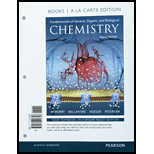
a)
Interpretation: Element that gain an electron more easily to be predicted.
Concept Introduction:
Ionization energy: The amount of energy required to remove an electron from the gaseous atom.
b)
Interpretation: Element that loses an electron more easily to be predicted.
Concept Introduction:
Ionization energy: The amount of energy required to remove an electron from the gaseous atom.
Electron Affinity: The amount of energy released when an electron is added to gaseous atom.
c)
Interpretation: Element that loses an electron more easily to be predicted.
Concept Introduction:
Ionization energy: The amount of energy required to remove an electron from the gaseous atom.
Electron Affinity: The amount of energy released when an electron is added to gaseous atom.
Want to see the full answer?
Check out a sample textbook solution
Chapter 3 Solutions
Fundamentals of General, Organic, and Biological Chemistry, Books a la Carte Edition; Modified Mastering Chemistry with Pearson eText -- ValuePack ... and Biological Chemistry (4th Edition)
- Balance the following (fictional) chemical equations by supplying the correct coefficient. Do not leave any space blank (in other words, write in 1 if you would be leaving it blank): R(OZ)2 - RY2+ Z20 a) ZY+ b) D2 (g) + L2 (g) – DL3 (e)arrow_forwardNitrogen reacts with powdered aluminum according to the reaction:2 Al(s) + N2( g) → 2 AlN(s)How many liters of N2 gas, measured at 892 torr and 95 °C,are required to completely react with 18.5 g of Al?arrow_forwardWhich of the following compounds would you expect to have the highest boiling pointand which the lowest boiling point? Explain your answer.(a) CH3OCH3 (b) CH3COOH (c) CH3CH2CH3arrow_forward
- For the following reactions, identify the atom(s) being oxidized and reduced:arrow_forwardCalculate the coulomb energy for the following three nuclei using the semi-empirical mass formula. a) 19F b) 48Tİ c) 63Cuarrow_forwardThe reaction between nitrogen and hydrogen to produce ammonia is described by the following equilibrium reaction. 3 H₂+ N₂ 2NH3 What substances are present in the reaction mixture when equilibrium has been obtained? ☐N₂ NH NH3 H₂arrow_forward
- In 1895 a student prepared three coordination compounds of chromium with the same formula CrCl2(H2O). The table below gives the color of each compound along with the number of CI ions in solution per formula unit of the compound. Complete the table by filling in the modern formula for each compound. Metal chromium has a coordination number of 6 in these compounds and an oxidation state of +2. Compound (a) Color Bright blue (b) Light green (c) Yellow Part 1 of 3 Modern formula for (a): х G CI Ions in Solutions per Formula Unit 2 1 0 00 olaarrow_forwardLook up the valence electron configuration, covalent atomic radius, effective nuclear charge, first ionization energy and Pauling electronegativity in Chapter 8 (tables are attached). Examine the above data and answer the following questions. a) Explain why some of the elements like TI and Pb on the lower left of the p block are metallic. b) Explain why some of the elements like C, Si in the center of the p block form covalent bonds. Explain why these bonds formed by the network of these elements (as studied in Chapter 25) tend to be unreactive. c) Explain why the noble Group 8A elements are highly unreactive gases. d) Explain why some elements like F, CI, Br etc, on the upper right of the p block are highly reactive nonmetals.arrow_forwardIdentify the acid on the left and its conjugate base on the right in the following equations:arrow_forward
- Which element is oxidized and which is reduced in the following reactions?arrow_forwardWhich of the following metal complexes are responsible for the reduction of molecular oxygen? Group of answer choices Fe(III)-Cu(II) complex Fe(III)-Cu(I) complex Fe(II)-Cu(II) complex Fe(II)-Cu(I) complex None of thesearrow_forwardElement Z forms an ion Z 3+, which contains 31 protons. What is the identity of Z, and how many electrons does Z3+have?arrow_forward
 Biology (MindTap Course List)BiologyISBN:9781337392938Author:Eldra Solomon, Charles Martin, Diana W. Martin, Linda R. BergPublisher:Cengage Learning
Biology (MindTap Course List)BiologyISBN:9781337392938Author:Eldra Solomon, Charles Martin, Diana W. Martin, Linda R. BergPublisher:Cengage Learning


